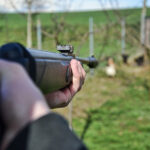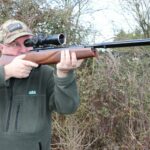Table of Contents
- 1 6.5 Creedmoor vs 7mm-08 Podcast
- 1.1 History Of The 6.5 Creedmoor & 7mm-08 Remington
- 1.2 7mm-08 vs 6.5 Creedmoor: Cartridge Sizes
- 1.3 7mm-08 vs 6.5 Creedmoor Ballistics
- 1.4 6.5 Creedmoor vs 7mm-08
- 1.5 7mm-08 vs 6.5 Creedmoor Ammo
- 1.6 7mm-08 vs 6.5 Creedmoor Rifles
- 1.7 6.5 Creedmoor vs 7mm-08: Which Is Right For You?
- 1.8 6.5 Creedmoor For Elk Hunting Podcast
- 1.9 NEXT: 6.5 CREEDMOOR vs 300 WIN MAG REVIEW AND COMPARISON
- 1.10 Enjoy this article comparing the 6.5 Creedmoor and 7mm-08 Remington cartridges? Please share it with your friends on Facebook and Twitter.
- 1.11 NEXT: 308 vs 30-06 SPRINGFIELD vs 300 WIN MAG: WHICH SHOULD YOU HUNT WITH?
Trying to decide between the 6.5 Creedmoor and 7mm-08 Remington cartridges? Here’s what you need to know about them.
The 7mm-08 Remington and 6.5 Creedmoor are both very popular hunting cartridges in North America. However, even though there is a big overlap in their capabilities, there are some significant differences between the 6.5 Creedmoor vs 7mm-08 cartridges that you should be aware of.
Unfortunately, there’s a lot of hype and misinformation out there regarding 7mm-08 Remington and the 6.5 Creedmoor that really muddies the water. This is especially true with the 6.5 Creedmoor. Not surprisingly, while each cartridge offers certain benefits to hunters, it’s still easy to get confused when trying to understand their actual strengths and weaknesses.
In this article, I’m going to discuss the pros and cons of the 6.5 Creedmoor vs 7mm-08 Remington cartridges so you can make an informed decision on which one is right for you.
Before we get started, I have two administrative notes:
Some of the links below are affiliate links. This means I will earn a small commission (at no extra cost to you) if you make a purchase. This helps support the blog and allows me to continue to create free content that’s useful to hunters like yourself. Thanks for your support.
Additionally, I recorded an entire podcast episode on this exact subject. If you’d rather listen than read, click the appropriate link below to listen to this episode on your preferred podcasting player.
Be sure to hit that “Subscribe” button in your podcast player!
6.5 Creedmoor vs 7mm-08 Podcast
Apple | Google | iHeart | Spotify | Stitcher
History Of The 6.5 Creedmoor & 7mm-08 Remington
As is the case with many cartridges, the story of the 7mm-08 Remington and the 6.5 Creedmoor really begins with the .308 Winchester.
First unveiled by Winchester all the way back in 1952, the new .308 Winchester cartridge quickly developed a reputation for accuracy, power, and efficiency with hunters and shooters. As is the case with many good cartridges, wildcatters and gun designers started modifying the .308 Winchester to develop new and more specialized wildcat cartridges almost immediately after it hit the market.
Among others, the .243 Winchester, .260 Remington, .338 Federal, and .358 Winchester are all descended from the legendary .308 Winchester as designers necked the case up or down as necessary to shoot smaller or larger 6mm, 6.5mm, .33 caliber, or .35 caliber bullets respectively.
Well, the 7mm-08 Remington is yet another cartridge derived from the .308 Winchester. Standardized by Remington in 1980, the 7mm-08 Remington uses a modified .308 Winchester case necked down to shoot 7mm bullets.
Similar to the difference between the 7-30 Waters and the .30-30 Winchester (or the .25-06 and the .30-06), by necking down the .308 case to shoot smaller caliber bullets, the designers of the 7mm-08 Remington built a cartridge with a higher velocity, flatter trajectory, more resistance to wind drift, and less recoil than the .308 Winchester.
The 7mm-08 Remington uses the same .284″ bullets as the 7mm Mauser and the 7mm Remington Magnum and provides a great balance of adequate power for hunting a wide variety of game, moderate recoil, and great external ballistics. Indeed, the 7mm-08 Remington was one of the most popular cartridges among deer hunters as well as for big game hunters in general who valued those characteristics for a very long time.
That eventually changed when the 6.5 Creedmoor came along and provided another option for hunters searching for something with those performance characteristics.
Unveiled in 2008, the 6.5 Creedmoor was the brainchild of Dave Emary and Dennis DeMille of Hornady Manufacturing. They designed the cartridge in an effort to gain an edge in high power rifle competition shooting, which had been long dominated by the .308 Winchester. Basically, they wanted a new cartridge that could fit in a short action magazine and was just as accurate as the .308, but with less recoil, less wind drift, and a flatter trajectory.
By modifying a .30 Thompson Center (.30 TC) case to shoot .264″ bullets, they successfully built a cartridge with a relatively large case capacity optimized for use with 4350 class propellants that could also accommodate long, heavy, high ballistic coefficient (BC) bullets without intruding into the powder column.
Named the 6.5 Creedmoor (sometimes misspelled Creedmoore or Creedmore) in honor of the Creedmoor Matches and designed for use with a relatively fast 1:8″ rifling twist rate, Emary and DeMille were quite successful in their goal of building the ideal competition shooting cartridge. A pretty representative 6.5 Creedmoor load shoots a 140 grain bullet at about 2,700 fps (2,266 ft-lbs). So, the 6.5 Creedmoor does not have eye popping ballistics, but it has minimal recoil, is very accurate, and uses high BC bullets that retain energy and resist wind drift exceptionally well.
Like the 7mm-08 Remington, the new 6.5 Creedmoor cartridge had less recoil, a flatter trajectory, and more resistance to wind drift than the .308 Winchester.
For those reasons, the cartridge has seen a great deal of success in the hands of competition shooters and has recently made the jump into the mainstream hunting community.
If you’d like to learn more about how the 6.5 Creedmoor and the 7mm-08 and compare to the .308 Winchester in more detail, read the articles below:
6.5 Creedmoor vs 308 Winchester Debate Settled
243 vs 7mm-08 vs 308 Winchester: Which Is Right For You?
7mm-08 vs 6.5 Creedmoor: Cartridge Sizes
You can see some of the similarities and differences between the 6.5 Creedmoor and the 7mm-08 Remington in the photo below.
First, the two cartridges are very similar in size and use a rimless bottlenecked case.
The 6.5 Creedmoor and 7mm-08 cartridges are designed for use in short-action rifles and have similar case lengths as well as overall lengths. Both cartridges also have the same .473″ rim diameter.
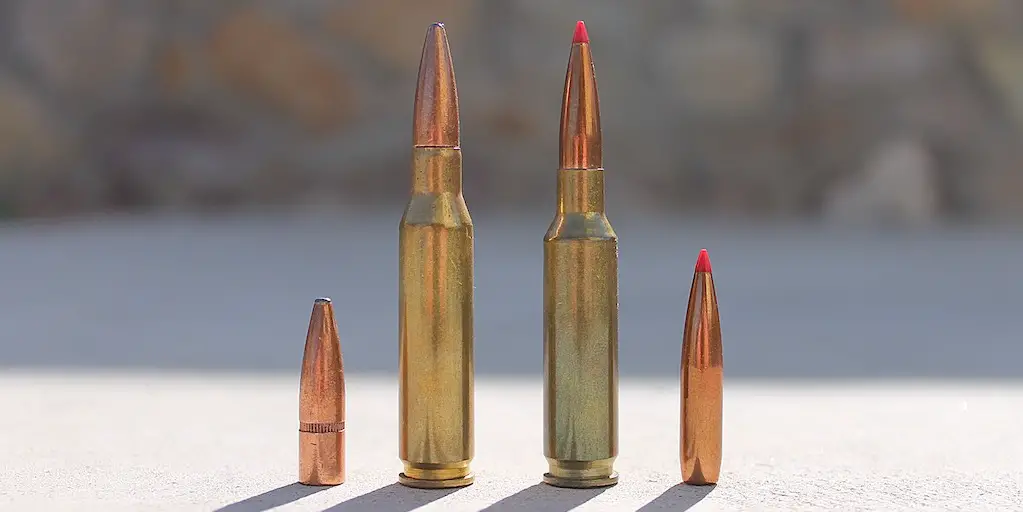
As far as differences go, bullet size is one of the most obvious differences between the 6.5 Creedmoor vs 7mm-08. Each cartridge uses different diameter bullets: .264″ (6.5mm) for the Creedmoor and .284″ (7mm) for the 7mm-08 Remington.
There is a big overlap in the most common bullet weights for each cartridge though. 7mm-08 Remington factory loads most often use 120-160 grain 7mm bullets. 120, 140, 150, and 160 grain bullets are the most common for that cartridge. On the other hand, the 6.5 Creedmoor most often utilizes bullet weights in the 95-160 grain range, with 120, 129, 140, and 143gr bullets being the most common.
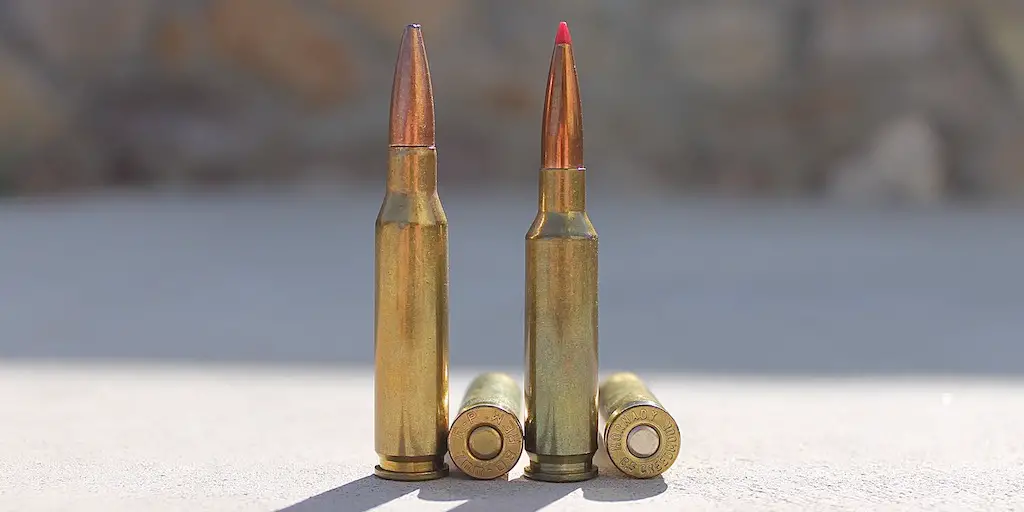
The 6.5 Creedmoor also has a slightly less tapered case with a steeper 30 degree shoulder (the 7mm-08 has a 20 degree shoulder). So, even though the 6.5 Creedmoor has a noticeably shorter case than the 7mm-08, the Creedmoor actually has a tiny advantage in case capacity.
The 6.5 Creedmoor is also loaded to a higher pressure than the 7mm-08 Remington (62,000psi vs 61,000psi).
Note: while the powder capacity figures listed below do give a good indication of the differences between the two cartridges, exact case capacities vary slightly according to the brand of brass used.
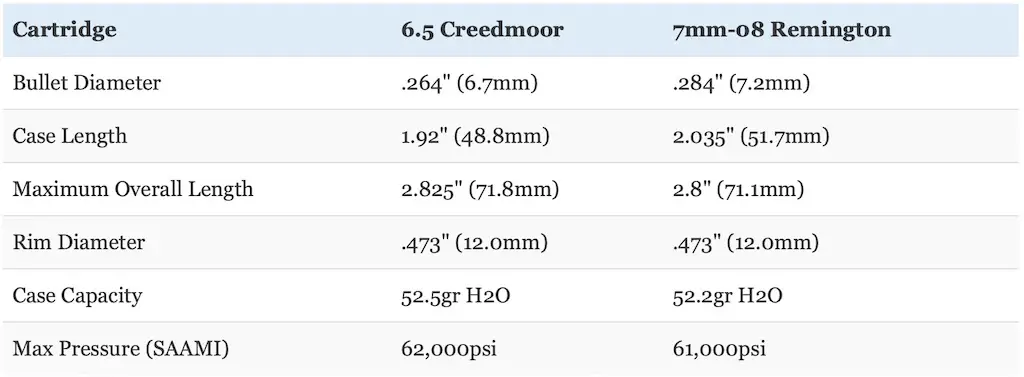
7mm-08 vs 6.5 Creedmoor Ballistics
The similarities and differences in the external dimensions of the 6.5 Creedmoor and the 7mm-08 Remington translate into some interesting differences in their ballistic performance.
This is illustrated in the table below comparing Hornady and Nosler factory ammunition. The 6.5 Creedmoor loads use a 140gr Ballistic Tip (.509 BC) and a 143gr ELD-X (.625 BC) while the 7mm-08 Remington loads use a 140gr Ballistic Tip (.485 BC) and a 150gr ELD-X (.574 BC).
All four loads used a 200 yard zero.
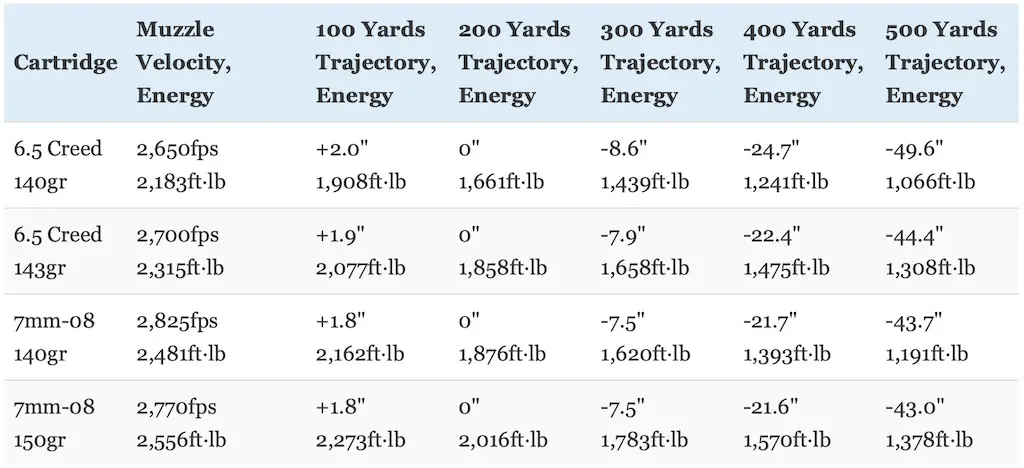
Interestingly enough, even though the 6.5 Creedmoor is touted as an outstanding long range cartridge, both of these 7mm-08 Remington loads outperform comparable 6.5 Creedmoor loads on paper at typical hunting distances. The differences between the two cartridges are admittedly very small in this area, but the 7mm-08 has a flatter trajectory (less bullet drop) and more kinetic energy than the 6.5 Creedmoor all the way out to 500 yards.
However, both of the 6.5 Creedmoor loads each use a more aerodynamic bullet with a higher ballistic coefficient. So, while the 7mm-08 starts off with somewhat more kinetic energy, the gap narrows as range increases.
With all that in mind though, realize that the two cartridges are actually very similar in performance in these areas.
The chart below compares how much a 10 mile per hour crosswind impacts those same 6.5 Creedmoor and 7mm-08 Remington loads out to 500 yards.

Once again we see that the two cartridges are fairly evenly matched. The 7mm-08 has a little bit less wind drift with the Nosler Ballistic Tip loads, but the 6.5 Creedmoor has a tiny bit less wind drift with the Hornady ELD-X loads. In each case, there’s 1″ or less of difference in wind drift at 500 yards between the two cartridges.
The table below compares the recoil produced by very similar loads to the Hornady loads compared above for each cartridge when fired from identical rifles.
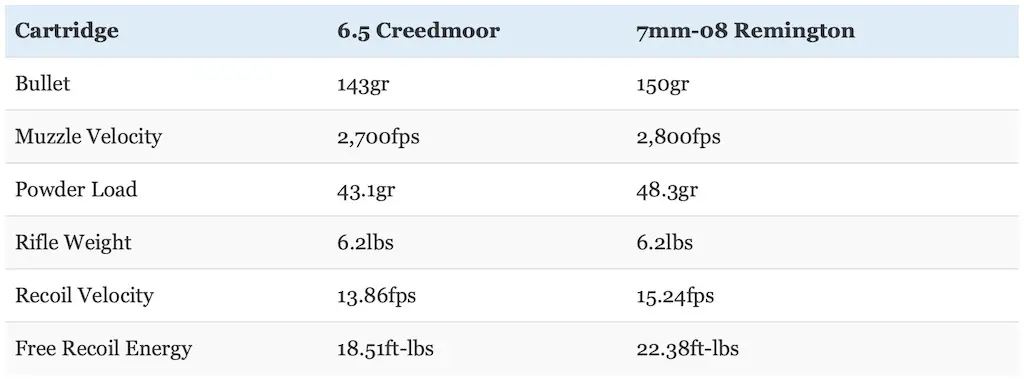
Felt recoil will vary from shooter to shooter and rifle to rifle, but free recoil energy is still a useful way to compare cartridges.
As you can see, the 6.5 Creedmoor has significantly less recoil than the 7mm-08 Remington. In this case, the 7mm-08 Remington has approximately 20% more free recoil energy than the 6.5 Creedmoor. That’s really saying something too because the 7mm-08 is known for pretty mild recoil itself.
Many shooters should be able to handle the recoil of both cartridges without much trouble, but the 6.5 Creedmoor has a big edge in this respect, especially for smaller or recoil shy hunters.
Don’t underestimate the impact that recoil has on the ability of a person to shoot accurately either. Some people do handle recoil better than others, but all other things being equal, they will absolutely shoot more accurately with a milder recoiling cartridge.
So where do we stand with each cartridge?
6.5 Creedmoor vs 7mm-08
The 6.5 Creedmoor fires smaller diameter and more aerodynamic bullets than the 7mm-08 Remington. Both cartridges have a similar trajectory, but the 7mm-08 retains more kinetic energy than the 6.5 Creedmoor at typical hunting ranges while the 6.5 Creedmoor has less recoil.
All things considered, the two cartridges are fairly evenly matched. 7mm-08 has tiny advantages in trajectory and retained kinetic energy downrange while the 6.5 Creedmoor has less recoil.
However the 6.5 Creedmoor and the 7mm-08 each have specific advantages over the other that are worth discussing.
The biggest advantage the 7mm-08 Remington has over the 6.5 Creedmoor is the fact that it uses larger diameter bullets.
Specifically, the larger diameter .284″ bullets used by the 7mm-08 have about 15% more frontal surface area (also known as cross sectional area) than the .264″ bullets used by the 6.5 Creedmoor (.0633 vs .0547 square inches). All other things being equal, a bigger bullet will make a bigger hole, cause more tissue damage, and result in more blood loss.
Especially when combined with the fact that the 7mm-08 carries more kinetic energy downrange than the 6.5 Creedmoor, those larger diameter bullets are certainly helpful when hunting larger game.
On the other hand, the 6.5mm bore diameter is also in something of a sweet spot where it’s easier to manufacture very high BC bullets that’s aren’t especially heavy. Those aerodynamic projectiles don’t slow down as fast and are more resistant to wind drift.
At the same time, the 6.5 Creedmoor also has a slight edge over the 7mm-08 in bullet sectional density, especially with heavier bullets.
Sectional density (SD) is a measure of the ratio of the diameter of a projectile to its mass. All other things equal, a heavier projectile of a given caliber will be longer and therefore have a higher sectional density and consequently penetrate deeper than projectiles with a lower mass and sectional density.
As an example, 120 grain and 143 grain .264″ bullets have sectional densities of .246 and .293 respectively. This compares favorably to 120 grain, 140 grain, and 150 grain .284″ bullets which have sectional densities of .213, .248, and .266 respectively.
So, the high SD bullets used by the 6.5 Creedmoor assist with penetration to help the cartridge “punch above its weight” in a manner similar to the 7x57mm or 9.3x62mm Mauser cartridges.
What about 6.5 Creedmoor vs 7mm-08 accuracy?
While the 7mm-08 Remington is certainly capable of outstanding accuracy (often sub-MOA), this is another area where the 6.5 Creedmoor most likely has the edge as well.
After all, the 6.5 Creedmoor was specifically designed as a competition shooting cartridge. At the same time, since it utilizes .264″ bullets, there is a bigger selection of high BC and high SD match grade hunting bullets available for the cartridge. That’s not to say that the 7mm-08 isn’t accurate or that there aren’t a bunch of good quality bullets available for it.
It’s just that the overall design of the 6.5 Creedmoor gives that cartridge an edge over the 7mm-08 Remington in potential accuracy.
7mm-08 vs 6.5 Creedmoor Ammo
The 6.5 Creedmoor is likely one of the 5 (maybe even 3) most popular cartridges in the USA right now. That said, even if it’s not quite as widely used as the 6.5 Creedmoor, the 7mm-08 Remington is also an extremely popular cartridge itself.
The big ammunition manufacturers like Barnes, Browning, Federal Premium, Hornady, Nosler, Remington, and Winchester all produce a variety of quality 6.5 Creedmoor and 7mm-08 Remington factory ammunition suitable for hunting.
During normal times, it’s usually very easy to find ammo for both cartridges and almost any gun or sporting goods store will have a wide variety of 6.5 Creedmoor or 7mm-08 ammo in stock.
Availability of ammunition is also usually excellent online and the bigger retailers typically have a good selection of quality factory ammo for both cartridges in stock.
BUY SOME EXCELLENT 6.5 CREEDMOOR HUNTING AMMO HERE
BUY SOME GREAT 7mm-08 REMINGTON HUNTING AMMO HERE
BUY MORE 7mm-08 REMINGTON HUNTING AMMO HERE
If you’d like to learn more details about some of the various hunting ammunition choices for the 6.5 Creedmoor and 7mm-08 Remington, read these articles:
Best 6.5 Creedmoor Ammo For Hunting Elk, Deer, And Other Big Game
Best 7mm-08 Remington Hunting Ammo For Deer, Elk, And Other Game
Reloading components for both cartridges are also widely available and there’s an especially wide variety of bullet choices for each cartridge.
The 6.5 Creedmoor shoots the same .264″ bullet size that’s also used by the 6.5×55 Swede, 6.5 Grendel, .260 Rem, and 6.5 PRC (among others).
The 7mm-08 Remington uses the same .284″ bullet size as the 7mm Mauser, .280 Remington, 7mm WSM, .284 Winchester, .280 Ackley Improved, 7mm Weatherby Magnum, and 7mm Remington Magnum.
Bullets like the Barnes LRX, TSX, TTSX, and TAC-X, the Berger Hybrid Hunter and VLD, the Hornady A-Max, ELD-X, GMX, InterBond, InterLock, and SST, the Nosler AccuBond, AccuBond Long Range, Ballistic Tip, E-Tip, and Partition, the Swift Scirocco and A-Frame, and the Federal Trophy Copper (just to name a few) are options for if you want to reload the 6.5 Creedmoor and the 7mm-08 Remington.
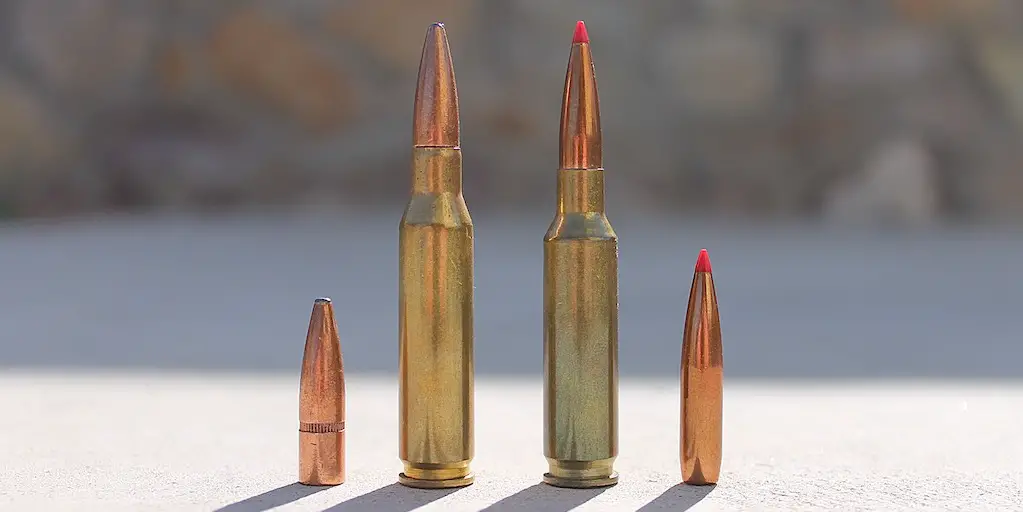
7mm-08 vs 6.5 Creedmoor Rifles
In addition to the abundant ammunition choices available in 7mm-08 Remington and 6.5 Creedmoor, there are also many quality rifles manufactured in these cartridges. Just like with ammunition, 6.5 Creedmoor rifles are a little more common than 7mm-08 rifles. Neither are rare though, so finding a good deer rifle shouldn’t be an issue regardless of which cartridge you choose.
Both cartridges are very common in bolt-action rifles like the Remington Model 700 and the Winchester Model 70. Additionally, the Browning AB3, Browning X-Bolt, Kimber Hunter, Mossberg Patriot, Nosler M48, Ruger American, Ruger American Predator, Ruger Hawkeye, Savage Axis, Savage 110, Tikka T3x, and Weatherby Vanguard are all available in both 7mm-08 Remington and 6.5 Creedmoor.
BUY A QUALITY 6.5 CREEDMOOR HUNTING RIFLE HERE
BUY A GREAT 7mm-08 HUNTING RIFLE HERE
Read the article below if you’d like to learn more details about some of the various hunting rifle choices for the 6.5 Creedmoor.
Best 6.5 Creedmoor Rifles For Hunting – Ultimate Guide
6.5 Creedmoor vs 7mm-08: Which Is Right For You?
Do you primarily hunt medium sized game like whitetail deer, feral hogs, or black bear at ranges within 200 yards? They’re both absolutely outstanding deer hunting cartridges and both cartridges will absolutely get the job done on medium sized game if you do your part and there isn’t a gigantic difference between them ballistically inside of 300 yards.
Are you looking for the better cartridge for long range hunting for game like mule deer or pronghorn in open country where you might need to take a shot at several hundred yards? Once again, both are great in this area, but the 7mm-08 has a tiny bit flatter trajectory and carries a little more energy out past 200 yards.
Do you want a hunting cartridge that’s well suited for caribou, moose, elk, eland, kudu, or red stag hunting? I consider both to be a little on the light side, but I’d lean towards the 7mm-08 in this area for most hunters because it shoots larger diameter bullets that carry more kinetic energy downrange. The 6.5 Creedmoor has a little bit less room for error, but will still work though, especially with heavy bullets.
Yes, you can hunt elk with the 6.5 Creedmoor, but you need to be aware of a couple of things before you go down that road.
To that end, I recorded an entire podcast episode on elk hunting with the 6.5 Creedmoor with someone who has cleanly taken elk with the cartridge. Our discussion does a great job of covering the pros and cons of the 6.5 Creedmoor for elk hunting and anyone planning on going elk hunting in the future should definitely listen to this interview.
Just click the appropriate link below to listen to this episode on your preferred podcasting service. Be sure to hit that “subscribe” or “follow” button if you like the show!
6.5 Creedmoor For Elk Hunting Podcast
Apple | Google | iHeart | Spotify
Are you sensitive to recoil and in need of a serious low recoil cartridge? The 6.5 Creedmoor has significantly less recoil than the 7mm-08 Remington, especially in a lighter rifle. This cartridge is especially well suited to new, small framed, and or recoil shy hunters. Indeed, a good rifle chambered in 6.5 Creedmoor is a great gift for a hunter who is just getting started.
Do you want the round that is best suited for target shooting out past 400 yards or so in a precision rifle? The 6.5 Creedmoor is significantly better for work at longer ranges since it has such mild recoil and is specifically designed to use very high BC bullets. It is hands down the best choice for long range shooting of the two cartridges.
The 6.5 Creedmoor and 7mm-08 Remington are both excellent rifle cartridges, albeit ones with different strengths and weaknesses. Though the differences between them (6.5 Creedmoor vs 7mm-08) are significant in certain respects, they’re suitable for a pretty big range of hunting tasks. Get a good hunting rifle chambered in the cartridge that you think fits your needs the best, learn to shoot it well, use quality bullets, and you’ll be all set for most hunting situations. Good luck!
NEXT: 6.5 CREEDMOOR vs 300 WIN MAG REVIEW AND COMPARISON
The Lyman 50th Edition (p183-184, 205-206) and Hornady 10th Edition (p317-322, 364-369) reloading manuals were used as references for the history of the cartridges. I obtained the data used to compare the trajectory and wind drift of the cartridges from Hornady (here and here) and Nosler (here and here). Data used to calculate recoil was obtained from the Hornady reloading manual. Case capacities were obtained from Chuck Hawks (here and here). Maximum pressure obtained from SAAMI (p23 & 24). I used ShootersCalculator.com to compare trajectory and recoil for the cartridges.
Make sure you follow The Big Game Hunting Blog on Facebook, Instagram, Twitter, and YouTube.














































